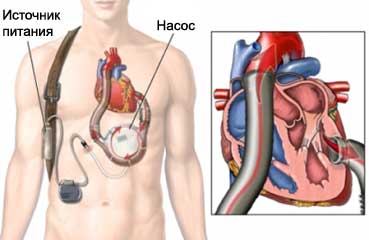Artificial ventricle – Ventricular assist device
Description of artificial ventricle
Artificial ventricle (SGF) It is essentially an artificial heart. This single chamber artificial heart works by compressed air or battery. Device It can cope with heart failure, ventricular.

Reasons for implantation of an artificial heart ventricle
SGF are used for people with end-stage congestive heart failure, that is incurable by medication. At the heart of the left ventricle does most of the work. Individual housing may be used for pumping blood from the left, right or both ventricles. Implantation of individual housing is the best way to restore normal cardiac activity without a heart transplant.
SGF is used most often in a waiting period heart transplant. However, modern devices are quite reliable, can operate for decades, and, perhaps, Soon a heart transplant will not be a necessity. Depending upon the overall health, after a period of recovery, patients can return to normal activities.
Heart failure occurs, when the heart is too weak, to pump all the blood. The blood begins to stagnate, first in lung (if not working properly left ventricle), and then the lower body, which causes swelling of the ankles.
Possible complications of the implantation of an artificial heart ventricle
If you plan to implantation of an artificial heart ventricle, you need to know about possible complications, which may include:
- Bleeding;
- Blood clots;
- Infection;
- Failure Device;
- Adverse reaction to anesthesia;
- Damage to the kidneys, light, hearts.
Factors, that may increase the risk of complications:
- Severe infections;
- Diseases of vital organs, except heart;
- Clotting disorder.
Besides, If you have a small growth, implantation impossible IZHS, because the device is quite bulky. But developing the next generation of devices, which have significantly smaller dimensions.
We need to discuss these risks with your doctor before surgery.
How is the implantation of an artificial heart ventricle?
Preparation for the procedure
If you need to set for individual housing construction, most likely, you'll be in line for a heart transplant. You, perhaps, already in hospital. The doctor will appoint a number of tests, eg:
- Echocardiogram – size, the shape and motion of the heart are studied using sound waves;
- X-rays – used, to take a picture of structures inside the body;
- Heart catheterization – used for the detection of coronary artery disease;
- Psychological and Social Assessment, To make sure, you are ready to use the device outside the hospital.
In the run-up procedure:
- Try not to eat for 8 hours before the procedure;
- Stop taking aspirin or other anti-inflammatory drugs for one week before surgery. You may need to stop taking blood-thinning drugs, such as:
- Clopidogrel;
- Warfarin.
Anesthesia
Used general anesthesia, which blocks any pain and support the patient during surgery in sleep.
Procedure implantation of an artificial heart ventricle
This procedure involves the use of open-heart surgery. The doctor makes an incision along the entire length of your breast bone. The sternum is divided and then be disclosed. You will be connected to a heart-lung machine (AIK). This device performs the function of the heart and lungs during surgery. The doctor puts the ML in the pocket on the inside of the abdominal wall. Cannulas (Tube for introduction into hollow organs) They will be sewn to the heart. SGF can also be sewn to the aorta, depending on the type of device.
Immediately after treatment
You will be in an intensive care unit (OBE) after treatment. For the body to connect sensors and life support. Medical staff will monitor vital signs.
How long will the implants IZHS?
About 4-8 hours.
The implantation of an artificial heart ventricle – Will it hurt?
You will experience pain after surgery. Doctor will prescribe pain medication, to save you from discomfort.
The average hospital stay
- 2-5 days in the ICU;
- 2-4 a week in a regular hospital room.
Care After implantation of an artificial heart ventricle
Home Care
When you return home, Follow these steps:, to ensure the normal recovery:
- Stay in contact with the cardiac center. You can expect a heart transplant;
- Gradually increase activity in accordance with the instructions of the doctor. Ask him, when you can go back to work;
- If prescribed by a doctor, you need to take blood thinners. This will prevent blood clots;
- Be sure to follow your doctor's instructions. He will tell you:
- How to care for individual housing construction;
- In the event of a life-threatening condition need to go to hospital.
Ask the doctor, when it is safe to shower, bathe, or to expose the cut by water.
Communication with the doctor after the implantation of an artificial heart ventricle
After returning home, you need to see a doctor, If the following symptoms:
- Signs of infection, including fever and chills;
- Redness, edema, increased pain, excessive bleeding, or discharge from the incision site;
- Increased pain;
- Weakness on one side of the body, blurred vision, or inability to speak;
- Cool, pale or blue limbs, numbness or soreness;
- Cough, shortness of breath or chest pain;
- Nausea, vomiting;
- Problems with urination and bowel movements;
- Redness or swelling in the legs;
- Indication of failure of the device.
